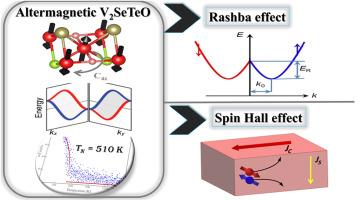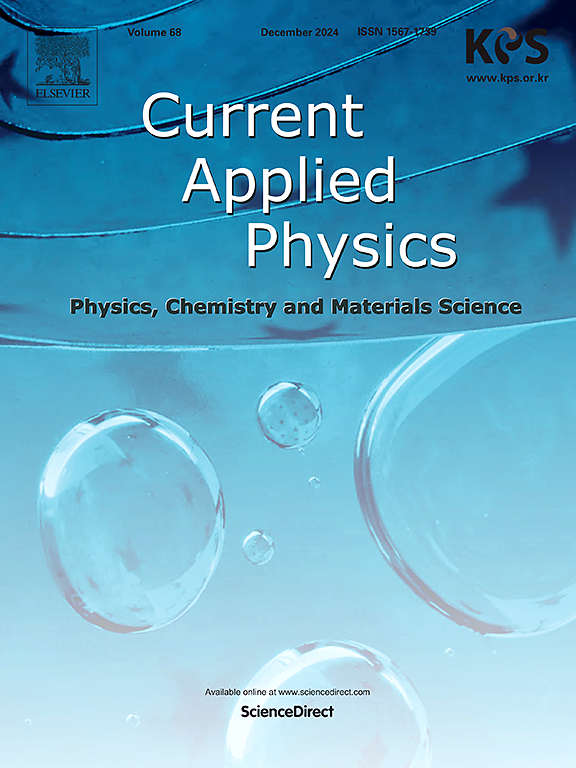随应变变化的拉什巴效应,以及变磁性 Janus V2SeTeO 单层中的自旋霍尔电导率
IF 2.4
4区 物理与天体物理
Q3 MATERIALS SCIENCE, MULTIDISCIPLINARY
引用次数: 0
摘要
超磁是一类独特的反铁磁材料,其特点是自旋带不重叠,吸引了大量研究人员的关注。在此,我们研究了 Janus V2SeTeO 单层的电子、磁性和自旋传输现象之间的相互作用。Janus 单层的直接带隙为 0.32 eV。Janus V2SeTeO 层具有沿 (110) 方向的面内磁各向异性。自旋轨道耦合(SOC)的加入诱发了拉什巴系数为 1.02 eV Å 的拉什巴型带状结构。相反,拉伸应变会抑制拉什巴系数,当拉伸应变达到 3% 时,拉什巴系数几乎为零。掺入空穴后,SHC 的最大值约为∼ -65 (ℏ/e)S/cm 。SHC 的大小与典型拓扑材料的 SHC 大小相当。总之,这项研究提供了对 Janus V2SeTeO 变磁体单层的磁性、Rashba 和自旋传输特性的基本见解。本文章由计算机程序翻译,如有差异,请以英文原文为准。

Strain-dependent Rashba effect, and spin Hall conductivity in the altermagnetic Janus V2SeTeO monolayer
Altermagnets represent a distinctive class of antiferromagnetic materials characterized by non-overlapping spin bands and attract extensive research efforts. Herein, we investigate the interplay among electronic, magnetic, and spin transport phenomena of the Janus V2SeTeO monolayer. The Janus monolayer has a direct band gap of 0.32 eV. The Janus V2SeTeO layer has an in-plane magnetic anisotropy along (110) direction. The incorporation of spin-orbit coupling (SOC) induces a Rashba-type band structure with a Rashba coefficient of 1.02 eV Å. The Rashba coefficient is insensitive to the compressive strain. In contrast, it is suppressed with tensile strain and becomes almost zero at 3 % tensile strain. The maximum SHC of around ∼ −65 (ℏ/e)S/cm is achieved with hole doping. The magnitudes of SHC remain comparable to those in typical topological materials. Overall, this investigation provides fundamental insights into the magnetic, Rashba, and spin transport properties of the Janus V2SeTeO altermagnet monolayer.
求助全文
通过发布文献求助,成功后即可免费获取论文全文。
去求助
来源期刊

Current Applied Physics
物理-材料科学:综合
CiteScore
4.80
自引率
0.00%
发文量
213
审稿时长
33 days
期刊介绍:
Current Applied Physics (Curr. Appl. Phys.) is a monthly published international journal covering all the fields of applied science investigating the physics of the advanced materials for future applications.
Other areas covered: Experimental and theoretical aspects of advanced materials and devices dealing with synthesis or structural chemistry, physical and electronic properties, photonics, engineering applications, and uniquely pertinent measurement or analytical techniques.
Current Applied Physics, published since 2001, covers physics, chemistry and materials science, including bio-materials, with their engineering aspects. It is a truly interdisciplinary journal opening a forum for scientists of all related fields, a unique point of the journal discriminating it from other worldwide and/or Pacific Rim applied physics journals.
Regular research papers, letters and review articles with contents meeting the scope of the journal will be considered for publication after peer review.
The Journal is owned by the Korean Physical Society.
 求助内容:
求助内容: 应助结果提醒方式:
应助结果提醒方式:


